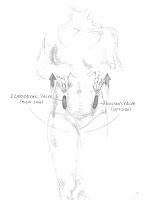Dear Yin Weaver,
How did you do with the Usha Mudra? Eve shared “(i)t makes me feel calm and centered. When I am under stress I often find that I will sit with my hands together in my lap. Even as a child.” I especially enjoyed how easy it was to practice this pose in any social situation.
Now it’s time to talk about our third chakra. It sits in the solar plexus and is also known as the solar chakra. The Sanskrit name is Manipura, which means “city of gems.” It is truly a gem of a chakra! As our fire center, it is the energy of combustion and transformation. A healthy third chakra will release energy for vitality, inspiration, creativity and transformation, physically and spiritually.
Psychologically, we find in this chakra the energy to transform the world by our thoughts and actions. That is why it is also associated with self esteem issues. If we feel good about ourselves and powerful, we are likely to have a positive impact on the world around us.
If we lack confidence, our inner fire will be banked, so to speak, and we may feel disempowered and easily overpowered by others. We will lack the motivation, will-power, self confidence and creativity to make a difference through sharing our gifts and talents.
On the other hand, if the energy of the third chakra is too strong, we might be angry, competitive, jealous, and have an inordinant need for power, status and recognition. Do you have trouble letting go? Are you obsessive, singleminded, bossy? Call the fire department! Fire in the hole!
So what’s your Challenge? Well, this week you get a choice. If you think you have a wimpy third chakra, and would like more self confidence, go for the Matangi Mudra. It’s one of my favorites. I used to practice it daily for years back when I had a wimpy third chakra. It really made a difference for me. However, if you need to tone it down a bit, try the second exercise. It’ll help you remember what it means to be a child again, humble and at rest.
MATANGI MUDRA
The Matangi Mudra promotes inner power and enthusiasm. Interlace the fingers together and extend the middle fingers. Hold your clasped hands in front of the solar plexus, just below the rib cage and in the center of the torso, the middle fingers pointing outwards.
BALASANA
Bala means child. Asana means pose. The child pose is meant to be a resting pose in yoga. If you happen to have a very, very good memory you may even remember resting this way in your crib as an infant. Let it soothe you and connect you to feelings of trust and calm.
Have you joined The Eden Project Fan Page on Facebook yet? Please do, and don’t forget to post your thoughts, comments and questions here or there.
Blessings,
Rose


















